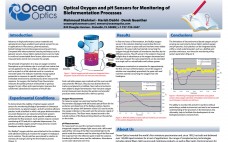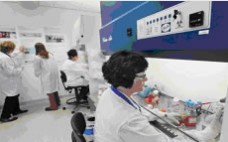SAFC has launched EX-CELL® CD Hydrolysate Fusion, the first fully chemically defined media supplement of its kind in the industry. Sartorius Stedim Biotech and SAFC Biosciences have recently announced a wide-ranging joint cooperation agreement to serve their customers. As a consequence of this effort, a range of 0.2 μm & 0.1 μm sterilizing grade filters from different membrane materials were tested for throughput & biological activity post-filtration. This paper provides an insight into superior total throughput performance of the Sartorius…
Sponsored Content
Improving influenza vaccine quantification; a comparative study of SRID and SPR
Reliable analytical tools are valuable for economical process development, production, and batch release of vaccines. The current method recommended by the European Pharmacopoeia and WHO for determination of influenza virus titer ¬ single radial immunodiffusion assay (SRID) is straightforward and easy, but leaves plenty of room for improvement when it comes to assay variability and speed of analysis. In addition to having low sensitivity and precision, the method is both time-consuming and quite labor-intensive. In this study a Biacore™ assay…
Optical Oxygen and pH Sensors for Monitoring Biofermentation Processes
Advances in high-performance sensor materials and optoelectronics have enabled optical sensors for use in markets including the life sciences, environmental, food and beverage, process control and biotechnology. Compared with traditional electrochemical sensing techniques such as galvanic, paramagnetic and fuel cell sensors, these optical sensors can be made in small and customizable form factors such as probes and self-adhesive patches. The sensors also have fast response, provide long-term stability and are chemically inert. This experiment demonstrates the viability of optical sensors…
Critical aspects for mixing of stratified solutions in vertical bags
With increasing use of single-use, disposable fluid processing systems, concerns of mixing arise in processes such as protein concentration, clarification and diafiltration. For some operating conditions of flow rate, solution viscosity or flow path configurations, protein solutions may become stratified in vertically-oriented hanging bags. This can cause decreased efficiency in cross flow applications. In this study, we modeled a stratified solution and tested the influence of these various operating conditions using ReadyCircuit* 2-D pillow bags. Even with viscous materials, flow…
Facing the Challenges in Bio-Pharmaceutical Production
Much attention has been given to ion exchange (IEX) media as a means to improve productivity as a result of increasing demand for higher efficiency on the downstream process. Until recently, strain optimisation for high productivity and upstream purification were the bottlenecks for most bio-processes. However, with the progress made in recent years, titers in fermentation processes have increased significantly. Obviously, this increased volumetric productivity will help reducing the cost of goods, but it also has an impact on the…
Global Material Harmonization for Increased Effectiveness and Reduced Risk
As geographic distances continue to metaphorically shrink, there is an increased focus on improving operational effectiveness. But, in order to increase effectiveness, it is important to understand and mitigate risk. In this on-demand webcast, Ben Locwin of Lonza Biologics demonstrates how material harmonization can help reduce risk and increase effectiveness by allowing:
• Use of one material specification
• Shared testing
• Shared raw material qualifications
• And more.
View this webcast to learn more about how synchronization of raw material testing can not only improve effectiveness, but reduce risk and lower costs as well.
Integrity Systems: A Comprehensive Toolkit for Single-Use Solutions
Single-use solutions are in growing demand within the biopharmaceutical manufacturing industry. With a complete line of solutions — from mixing systems to ultra-clean packaging — ATMI LifeSciences is a leader in these technologies. In this educational webcast, Jared Hisle, Global Product Manager at ATMI LifeSciences, explores the full line of Integrity™ Systems single-use technologies, including:
• NewForm™ Sterilizable Packaging
• Integrity™ Liquid and Powder Vessels
• Integrity™ Mixers
• Integrity™ Bioreactors
ATMI maintains the world’s largest installed base of single-use mixing systems and offers the world’s only single-use platform including film extrusion. Join Hisle as he demonstrates the advantages of ATMI’s single-use solutions.
Quality by Design (QbD): Defining Hydrolysates & Designing Quality
Complex. Undefined. Variability. These are all typical attributes that are used to describe protein hydrolysates because they are exactly that — complex, undefined and their performance may vary on a lot-to-lot basis. But despite all of the uncertainties, using hydrolysates as media supplements can stimulate cell growth and improve protein production — and ultimately lower the cost of goods tremendously. That is why the scientists at FrieslandCampina Domo have started the project “Defining Hydrolysates and Designing Quality.”
In this educational webcast, Dr. Jan Boots of FrieslandCampina Domo answers the questions — Can hydrolysates be defined? And can consistent quality be designed into them? Join Dr. Boots as he explores the complexity of hydrolysates and how Domo is working to define them.
Preclinical Immunogenicity Assessment
Protein therapeutics can potentially elicit immune responses when administered in humans. These antidrug antibodies could result in partial or complete loss of drug efficacy and other complications that have the potential to cause severe adverse effects in the patient. In this webcast, Philippe Stas, Head of Applied Protein Services at Lonza, discusses the benefits of preclinical immunogenicity assessment, including:
• Early-stage Risk Assessment
• Improved Quality and Safety of Drugs
• Reduced Attrition Rate in Drug Development Programs
View this webcast to learn more about managing drug-induced immune responses at the earliest possible stage to produce safer and more cost-effective protein therapeutics.
Quality, Speed and Flexibility by Design
Accelerating the path to new biomanufacturing capacity typically corresponds with increased costs and the risk of lower quality. Overcoming these compromises requires a holistic QbD-based rethinking of how biomanufacturing is approached. By rethinking biomanufacturing equipment, facility design and services, Xcellerex has achieved dramatic improvements in deployment time, while also reducing capital investment, operating costs, and improving overall quality and compliance. This webcast discusses the advantages of the FlexFactory® Biomanufacturing Platform, such as:
• Multi-product, simultaneous manufacturing
• Open platform for any bioprocessing technology/process control
• 70% reduction on time to build/validate to GMP ready (9mo.)
• And more.
Join Parrish Galliher, Founder and Chief Technology Officer at Xcellerex, as he provides an in-depth look at the technology behind Xcellerex’s FlexFactory Biomanufacturing Platform.









